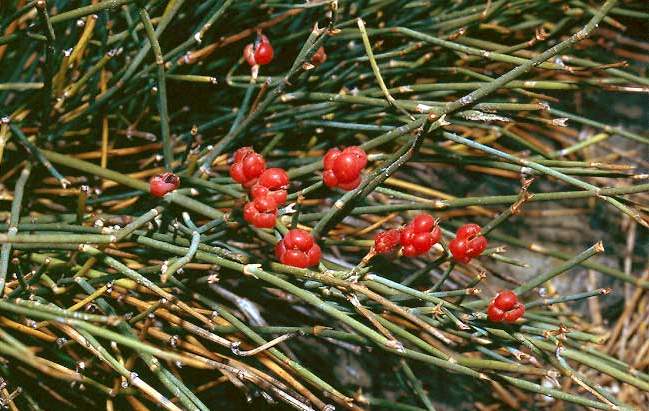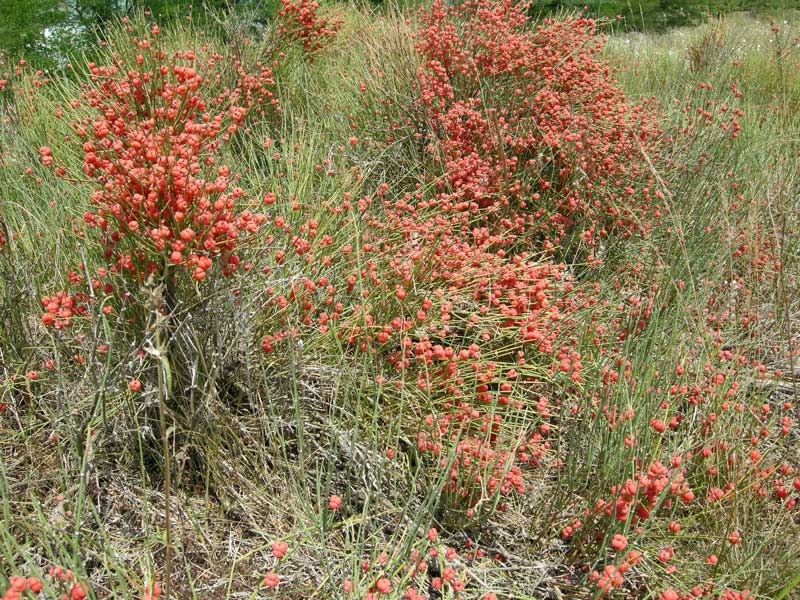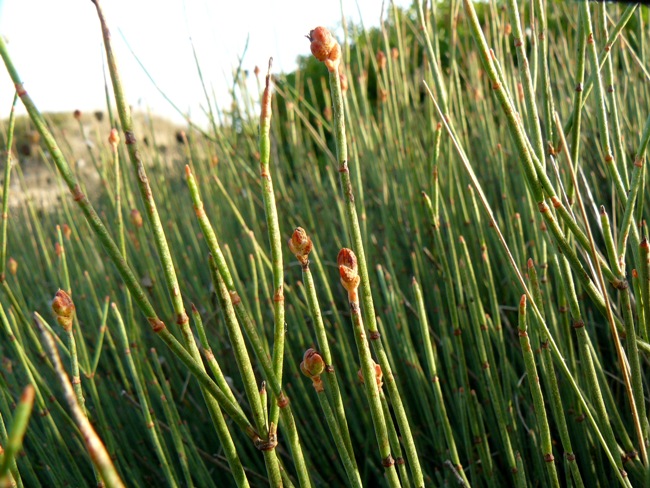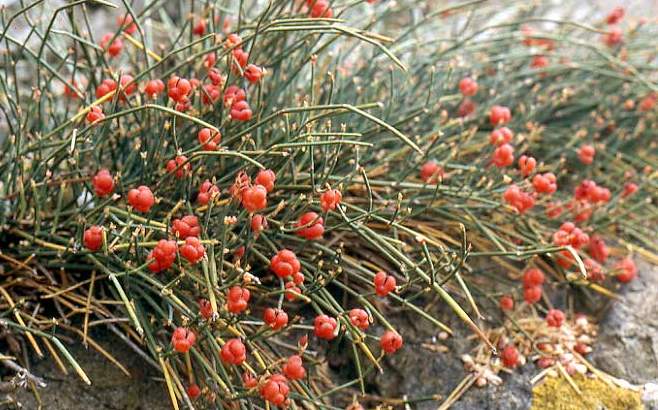Ephedra
Ephedra distachya
The most likely candidate of the non-hallucinogenic, stimulant hypothesis is a species of the genus Ephedra. Ephedrine, the agent substance in this plant, has a chemical structure similar to amphetamines, and it results in high blood-pressure, and according to anecdotal reports, it has a stimulating effect more potent than that of caffeine. Ephedra plants are bushes, measuring between 0.2 and 4 meters, with numerous green or yellowish stems. There are some 40 species, mainly Eurasian. The species growing in mountainous regions have the highest ephedrine content (up to 3% in the case of Ephedra equisetana). The marrow in the stems is brown-coloured in some species, reminiscent of Sanskrit babhru ("greyish-brown"), used exclusively in the Vedas to describe the Soma extract. The different species of Ephedra are not well known, and their taxonomy is in a state of confusion. Assuming a Pontic-Caspian home of Indo-Iranian religion (see Kurgan), the only likely candidate is Ephedra distachya, still used in Iranian folk medicine, and most notably still used as haoma by the Parsis. The native name for Ephedra in most Indo-Iranian languages of Central Asia is derived from *sauma- (e.g. Nepali somalata, Pashto oman/unan, Baluchi hum/huma/uma)
Archaeological evidence
Excavations of a early 2nd millennium BC BMAC site in the Kara Kum desert, Turkmenistan (Gonur South) revealed ceramic bowls in the context of a temple or shrine. The vessels were analysed by Professor Mayer-Melikyan and yielded traces of both Ephedra and Cannabis. In an adjacent room, ceramic pot-stands were found which appear to have been used in conjunction with strainers designed to separate the juices from the twigs, stems and leaves of the plants. A shrine at a later site (Togoluk 1, mid-second millennium) revealed a similar pottery strainer, but without traces of hallucinogenics. The late second millennium site Togoluk 21 yielded vessels containing traces of Ephedra again,in conjunction with pollen of poppies. These finds support the theory that the Indo-Iranian Sauma drink was a composite psychoactive substance comprising of Ephedra and variously Cannabis or Opium, and probably other ingredients, and the identification of the Sauma plant with Ephedra.
Persian Haoma
The Iranian peoples called the drink Haoma. In Persia, the early Aryan rituals were reformed by Zoroaster. Our knowledge is sketchy, but evidence of the formerly great importance of the ritual may be glimpsed from the Avesta (particularly in the Hōm Yast, Yasna 9–11), and Old Iranian *hauma also survived as Middle Persian hōm. The plant Haoma yielded the essential ingredient for the ritual drink, parahaoma.
In the Hōm yašt, the god (yazata) Haoma appears to Zoroaster "at the time of pressing" (havani ratu) in the form of a beautiful man and exhorts him to gather and press Haoma plants (Y.9.1,2). Haoma's epitheta include "the Golden-Green One" (zairi-, Sanskrit hari-), "righteous" (ašavan-), "furthering righteousness" (aša-vazah-), and "of good wisdom" (hu.xratu-, Sanskrit sukratu-).
Haoma grants "speed and strength to warriors, excellent and righteous sons to those giving birth, spiritual power and knowledge to those who apply themselves to the study of the nasks" (Y. 9.22). As the religion's chief cult divinity he came to be perceived as its divine priest. Ahura Mazda is said (Y. 9.26) to have invested him with the
sacred girdle, the aiwyånghana- and (Y. 10.89) to have installed Haoma as the "swiftly sacrificing zaotar" (Sanskrit hotar) for himself and the Aməša Spəntas. Haoma services were celebrated until the 1960s]] in a strongly conservative village near Yazd.
Haoma has been associated with Biblical tradition, and Christian mythology. According to the Parsi translator of the Zend Avesta, James Darmesteter, Haoma
comprises the power of life of all the vegetable kingdom ... the zarathustri scriptures say that Haoma is of two kinds, the White Haoma and the Painless Tree ... could it be that soma is the Tree of Life? the giver of immortality?
Marcel Eliade speculated on a Zoroastrian origin for the Grail Myth:
In a work published in 1939, the Parsi Scholar Sir Jahangir C. Coyajee has also remarked upon the analogy between the Grail and the Iranian Glory, xvarenah, and the similarities between the legends of Arthur and those of the fabulous King Kay Khorsaw. Let us add that in the cycle of compositions posterior to Wolfram von Eschenbach, the Grail is won in India by Lohengrin, Parzival's son, accompanied by all the knights.

The european alpine Ephedra species.
Due to import restrictions we are unable to ship Ephedra seed to Australia!Growing instructions
Sow seeds in sandy soil. Do not cover the small seeds, but press gentle into the earth. Keep seeds in constant moisture with temperatures of about 20 °C (68 °F).
Due to import restrictions we are unable to ship Ephedra seed to Australia!Growing instructions
Sow seeds in sandy soil. Do not cover the small seeds, but press gentle into the earth. Keep seeds in constant moisture with temperatures of about 20 °C (68 °F).


نامهاي ديگر آن: افدرا، افدرين، پَدرخ، خُم، ريش بز، خيم، قاطر قويروخي، قويروخ، علي جونك، علي جون، هوم و هوم المجوس ميباشدتیره افدرا دارای یک جنس و متجاوز از 35 گونه است که به وضع فاصله دار و دور از یکدیگر در نواحی مختلف کره زمین پراکنده اند. فراوانی آنها بیشتر در آمریکای شمالی و جنوبی و برخی نواحی آسیاست. تیره افدرا دارای یک جنس و متجاوز از 35 گونه است که به وضع فاصله دار و دور از یکدیگر در نواحی مختلف کره زمین پراکنده اند. فراوانی آنها بیشتر در آمریکای شمالی و جنوبی و برخی نواحی آسیاست.
گیاهانی عموماَ دو پایه (بندرت یک پایه) بالا رونده و یا به صورت بوته هائی با اعضای چوبی و به ارتفاع در حدود یک متر و گاهی بیشتر می باشند. ساقه آنها دارای انشعابات فراوان ظاهر بند بند و غلافی از فلس ها در هر بند است که برگهائی رشد نیافته آن به حساب می آیند. ساقه کلروفیل دار این گیاهان عهده دار عمل جذب سبزینه ای در آنها می باشد. گلهای نر آنها مجتمع به صورت شاتونهائی در محور ساقه و دارای 2 تا 6 بساک واقع بر روی یک میله مشترک است هر یک از آنها نیز در کناره یک براکته گل آذین قرار دارد. در قاعده هر پرچم معمولاً دو براکته نازک دیده میشود که از قاعده به یکدیگر پیوسته بوده نوعی پوشش بسیار کوچک برای آن بوجود می آورند. گلهای ماده آنها معمولاً در انتهای شاخه های به صورت منفرد یا دسته های 2-3 تایی محصور در 2-4 زوج براکته (دو به دو متقابل) قرار دارند. دو براکته فوقانی آنها به یکدیگر پیوسته بوده پوشش کیسه مانند که در انتها باز می باشد برای تخمک بوجود می آورند. افدراها فاقد میوه حقیقی هستند معهذا براکته داخلی گلهای ماده آنها پس از آمیزش تخمک چوبی گردیده برای آن پوشش سختی بوجود می آرود در حالیکه براکته خارجی گوشتدار شده مجموعاَ مشخصات یک میوه شفت برای آن فراهم می شود در ایران انواع متعددی از Ephedra ها در نقاط مختلف مخصوصاً نواحی بابر می رویند. بعضی از آنها نیزدر دامنه کوهستانهای خشک یافت می شوند

3 comments:
دوست عزیز گیاه هوم در نواحی بایر می روید و عکس که گذاشتید به هومی که من در یزد دیدم نمی خوره و بقیه عکس ها نشان دهنده این است که گیاه باید در ناحیه پر ابی باشد
salam golam baleh in hamon armak marofeh shamen ha hast ama oni ke to iran hast ghodrat kamtari dareh ke asmeh almish agar khasti barat migam
Congratulations for your knowledge I think you have reached to self-realization.It is my honor to be in touch with you.
Post a Comment